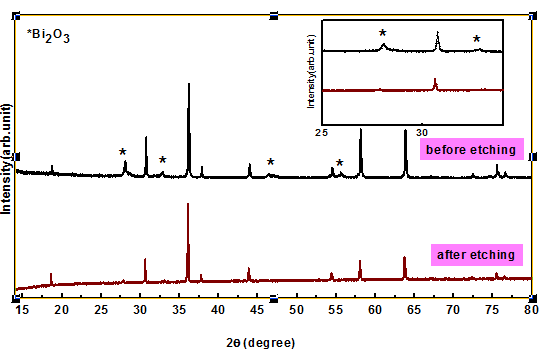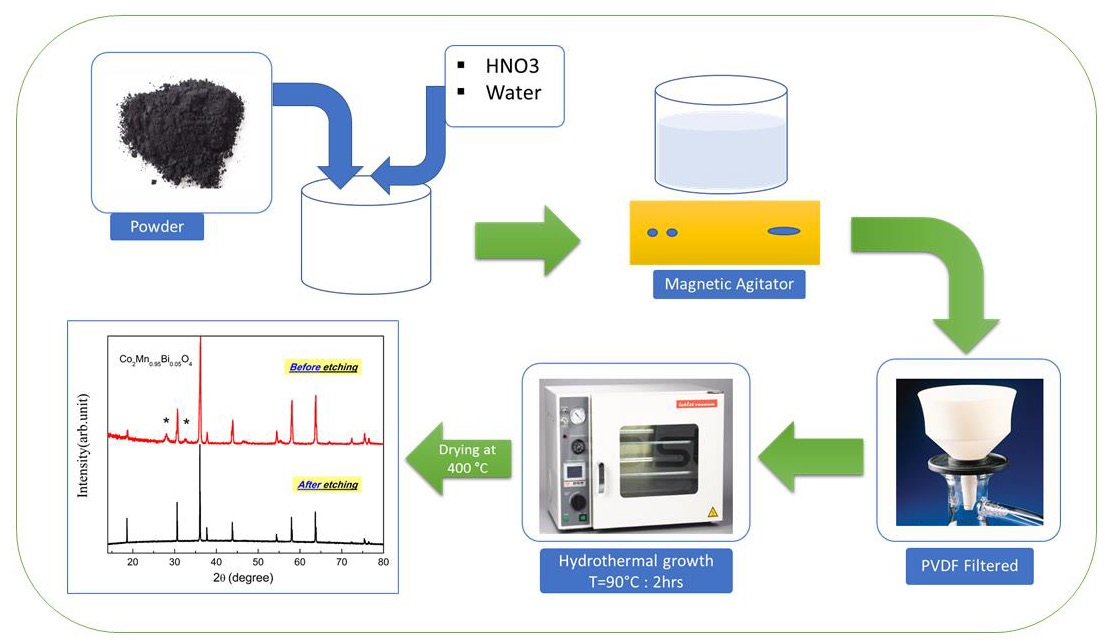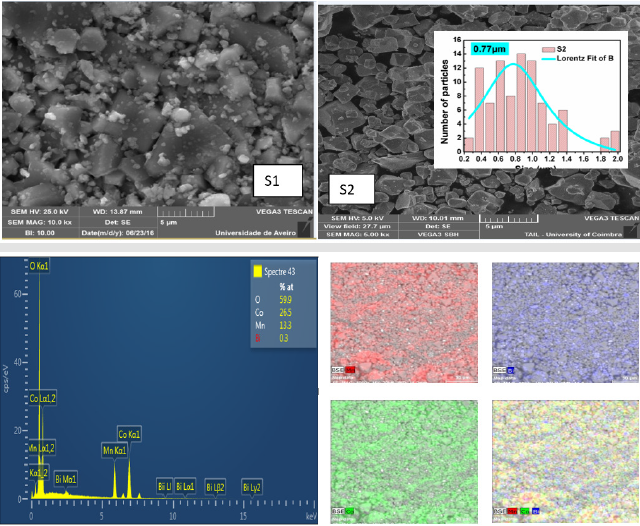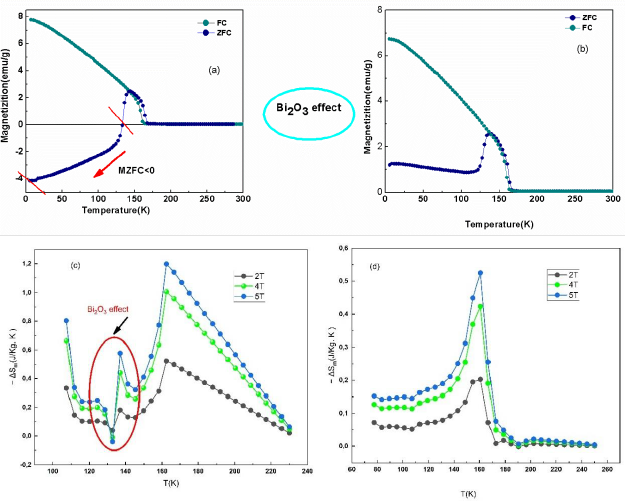ABSTRACT
This work reports the effect of impurity phase Bi2O3 via the Chemical etching process. Co2Mn0.9Bi0.1O4 was prepared by the sol-gel method. X-Ray Powder Diffraction (XRD) test showed that this sample is mainly composed by a Fd3−m cubic structure with a minor impurity phase of Bi2O3, which was practically removed without structural degradation by the chemical etching process. Our experiment results indicate that the phase Bi2O3 strongly influences the magnetic proprieties of this system, causes the negative magnetization, and causes the presence of polarity reversal in – ΔSm
Abbreviations: XRD: X-Ray Powder Diffraction; SEM: Scanning Electron Microscopy; EDX: X-Ray Energy Dispersive; ZFC: Negative Magnetization Values
Introduction
Spinel compounds have attracted a great research interest due to their potential applications in magnetism, magnetic recording, RF devices, microwave and in the high-frequency electronic circuit components [1-3]. Among various spinels, spinel cobaltite exhibits a wide variety of crystallographic, electronic and magnetic properties due to the mixed valence of both the Co and Mn elements [4-6]. CO2MnO4 is an inverse spinel oxide that crystallizes in an Fd3−m (Z=8) space group and has a structural formula (Co)8a [CoMn]16d(O)32e. For Spinel structure compounds, the physical properties can be altered by adding dopants and using the suitable route for the synthesis. The doping of rare metal ions in the CO2MnO4 modify the physical properties. Several works have unified these properties. Tai-Chun Han et al. synthesized the Y-doped CO2MnO4 and showed that this compound can be used in Multiferroic devices [7]. Moreover, Rajeevan et al. showed that Bi substitution in CO2MnO4 stabilized the ferroelectric transition and enhanced the dielectric constant [8]. According to the literature, synthesis of materials with single phase is associated with the doping level and the choice of dopant. The bismuth is the most important element accompanied by spurious phases. For example, the Bi2Fe2O9 impurities on BiFeO3 [9], the formation of Bi2O3 impurities on high Bi content CoBixFe2- xO4 [10], Bi2O3 and BiO spurious phases for CoBixFe2-xO4 [11]. Thus, understanding the influence of this impurity phase on the magnetic and electrical properties is important for their practical applications. Firstly, whether the presence of impurities based on Bismuth content enhances the physical properties of CoBixFe2- xO4 [12]. Secondly, which effect is the absence of these impurities expected to have. In this work, investigate the effect of Bi2O3 on the magnetic and magnetocaloric properties of Co2Mn0.9Bi0.1O4 via a chemical etching process.
Characterizations
Phase-purity and crystal structure of our compound were characterized XRD, are realized with a Philips PW1700 X-ray diffractometer with Cu-Ka radiation (λ = 1.5418 Å) in the 2 range from 15 to 80°. The sample morphology is characterized by Scanning Electron Microscopy (Sem), performed on a Vega3 Tescan microscope. The magnetic measurements were measured using a VSM magnetometer from 4 K to 300 K with magnetic field of 1 T.
Results and Discussion
The compound Co2Mn0.9Bi0.1O4 (S1) was prepared using the solgel method reaction, the process was described in detail elsewhere [13]. X-ray diffraction measurements revealed the existence of spurious reflections belonging to Bi2O3 as shown in Figure 1. Thus, to eliminate this impurity, we performed etching attacks for short time, The Chemical etching process is illustrated in Figure 2. The XRD of Co2Mn0.9Bi0.1O4 (S2: after etching) suggests single-phase with the same space group Fd-3m, indicating that the etching process was practically successful with no alteration of the crystallographic structure. This process was used to remove impurity phases [14-17]. The micro-structural evolution of S1 powder at room temperature was studied by SEM digital images. Figure 3 presents the SEM micrographs of the (S1) before the etching process, showing clear traces of bismuth oxide. After etching, the SEM micrographs of the Co2Mn0.9Bi0.1O4 (S2) show a uniform morphology, with grains of a relatively regular shape and homogeneously distributed over the surface. However, no spurious phases were observed, confirming our XRD results.
X-Ray Energy Dispersive (Edx) analyses allowed evaluating the final composition for each sample showed the presence of all elements (Mn, Bi, Co, and O), which confirms that the etching process eliminated just the second phase. Figure 4 shows Negative Magnetization Values (ZFC) below 130.2 K for sample S1 was reported by us. According to the results reported in the literature, a number of mechanisms and models were proposed to explain the phenomenon of negative magnetization, such as the presence of uncompensated spins at grain boundaries [18], imbalance of spin and orbital moments, and negative exchange coupling among ferromagnetic sub-lattices [19,20]. Some authors [21] have concluded that magnetic lattice defects either in the form of a non-magnetic atom substitution or vacancies could be the primary reasons for such anomalous temperature dependence. We observed the absence of negative magnetization values for the etched compound, Therefore, in our case based in chemical etching process we show that this negative magnetization is caused by the presence of a non-magnetic second phase Bi2O3. The other interesting manifestation of the presents second phase Bi2O3 is seen in the form of an unusual magnetocaloric effect MCE (- ΔSm), The MCE results from a magnetic entropy change ΔSm of a material upon application of an external magnetic field. The - ΔSm in a magnetic material can be derived from the dc magnetization curves using the following expression:

Where 1 2 ΔH = H − H ≥ 0 , Figure 4c depicts the polarity reversal of − ΔSm of S1 occurs, and it results in a heating instead of a cooling under the same refrigeration cycle. This means that the system can be used as a” constant temperature bath” of 140 K. This phenomenon was also observed in the previous works [22,23]. In summary, based one- time chemical etching we showed that the presence of a very small amount of (Bi2O3) can strongly influence the magnetic proprieties of this system, causes the negative magnetization and caused the presence of polarity reversal in − ΔSm. more than the present work also gives a concept of the utilization of magnetic cooling and heating phenomena in a single compound for making a self-driven constant temperature bath.
Figure 4: The Temperature dependence of the DC magnetization (a and b), (c) and (d) the Temperature variation of the magnetic entropy change − ΔSm of S1 and S2.
Highlights
1. The Co2Mn0.9Bi0.1O4 sample is prepared using sol-gel technique.
2. The chemical etching process was practically removed the impurity phase of Bi2O3
3. The impurity phase of Bi2O3 strongly influences the magnetic.
4. (Bi2O3) caused the presence of polarity reversal in − ΔSm
References
- A Goldman (2001) Magnetic Components for Power Electronics. Springer.
- DW Bruce (2010) Functional Oxides. Wiley.
- T Abraham (1994) Am Ceram Soc Bull 73: 62.
- MB Salamon, M Jaime (2001) Modern Physics Letters 73: 583.
- PA Joy, SK Date (2001) Journal of Magnetism and Magnetic Materials 210: 31
- Neha Garg, Monu Mishra, Govind, Ashok Kumar Ganguli, RSC Advances 10: 1
- Tai Chun Han, Sheng Shiang Pan, Yuan Hsun Liu (2014) Enhancement of multiferroic properties in Y-doped Co2MnO4 Journal of applied physics 116: 244104
- NE Rajeevan, R Kumar, DK Shukla, PP Pradyumnan, SK Arora, et al. (2009) Sci Eng B 163: 48.
- Fabian EN Ramirez, Gabriel AC Pasca, Jose A Souza (2015) Possible misleading interpretations on magnetic and transport properties in BiFeO3 nanoparticles caused by impurity phase. Physics Letters 379(24-25): 1549-1553.
- Maria Elenice dos Santos, Rafael Aparecido Ferreira, Paulo Noronha Lisboa Filho, Octavio Pen (2013) Journal of Magnetism and Magnetic Materials 329: 53-58
- Shyam K Gore, Rajaram S Mane, Mu Naushad, C Santosh S Jadhav, et al. (2015) Influence of Bi3+-doping on the magnetic and Mössbauer properties of spinel cobalt ferrite. 44: 6384
- Hyam K Gore, Santosh S Jadhav, Vijaykumar V Jadhav, SM Atange, Mu Naushad, et al. (2017) The structural and magnetic properties of dual phase cobalt ferrite. Scientific Reports 7(1):1-9.
- H Chouaya, M Smari I, Walha E, Dhahri, MPF Graça, et al. (2018) Journal of Magnetism and Magnetic Materials 451: 344-350.
- G Catalan, JF Scott (2009) Physics and Applications of Bismuth Ferrite. Adv Mater 21(24): 2463-2485.
- MM Kumar, VR Palkar, K Srinivas, SV Suryanarayana (2000) Ferroelectricity in a pure BiFeO3BiFeO3 Appl Phys Lett 762764.
- D Lebeugle, D Colson, A Forget, M Viret, P Bonville, et al. (2007) Room-temperature coexistence of large electric polarization and magnetic order in BiFeo3 single crystals. Phys Rev B 76: 024116.
- D Lebeugle, D Colson, A Forget, M Viret, P Bonville, et al. (2007) Very large spontaneous electric polarization in BiFeO3 single crystals at room temperature and its evolution under cycling fields. Appl Phys Lett 91: 022907.
- Dimple P, Dutta, J Manjanna, AK Tyagi J (2009) Magnetic properties of sonochemically synthesized CoCr2O4 Appl Phys 106: 043915.
- N Menyuk, K Dwight, DG Wickham (1960) Magnetization reversal and asymmetry in cobalt vanadate (IV) Phys Rev Lett 4: 119.
- N Sakamoto (1962) Magnetic properties of cobalt titanate. J Phys So Jpn 17: 99
- Amit Kumar, SM Yusuf (2015) Neutron scattering of advanced magnetic materials Physics Reports 556: 1-34.
- IL Prejbeanu, M Kerekes, RC Sousa, H Sibuet, O Redon, et al. (2007) Thermally assisted MRAM. J Phys Condens Matter 19: 165218.
- SM Yusuf, Amit Kumar, JV Yakhm (2009) Temperature- and magnetic-field-controlled magnetic pole reversal in a molecular magnetic compound. applied physics letters 95: 182506.

 Mini Review
Mini Review



